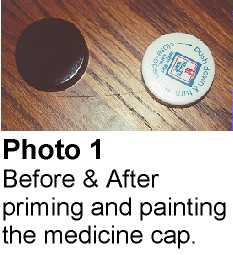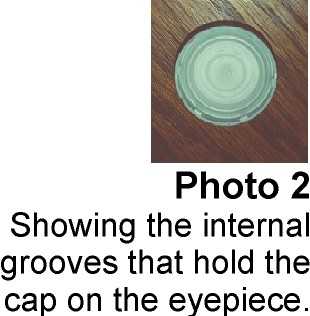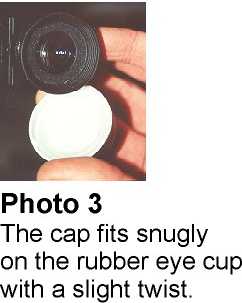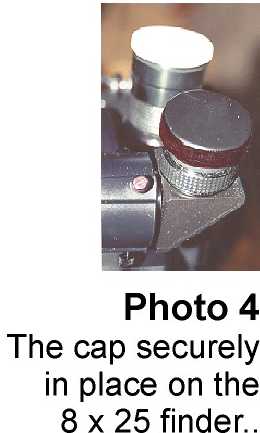ETX TECHNICAL TIPS
Last updated: 31 January 2001
ETX TECHNICAL TIPS |
MAKING THE MOST OUT OF YOUR STANDARD ETX FINDERSCOPE
Lately there have been several comments about the standard Meade finderscope that comes on the ETX series of scopes as being "...useless," "....bothersome to use," "...a real pain in the..."
This tip is somewhat in defense of the little finderscopes that Meade puts on its ETX. On the ETX 90, there is the 8 x 20 straight-through model and on the ETX 125 is the right angle 8 x 21 finder (essentially the same finder, but with the right angle prism on the larger scope).
I must agree, firstoff, that the straight through finder on the ETX 90 is REALLY a pain...in the neck, as it is located so close to the optical tube assembly (OTA) and one must negotiate getting behind the telescope even when located near the zenith or overhead. This is particularly bothersome with the ETX 90EC which operates alt-azimuth whereas the finder eyepiece is sometimes UNDER the telescope and unreachable except by very experienced hampsters.
Now, having agreed with the discomfort, I must say that I have extensively tested, both in my shop and in the field, both versions of the scope and have found the little finder to be amazingly EXCELLENT QUALITY! That's right....it is really a good and useful little telescope. If only you can get to it.
A lot of people misinterpret the value of a finder; in this case as in most telescopes, "bigger is NOT necessarily better." A finder is just THAT - to find things in a cross hair that is supposedly lined up parallel to the main telescope.
Acquisition....that is all a finder is for.
The "red dot" finders on the market are nice (I like to use one for High Precision so that I can verify naked eye what star my telescope has selected for H.P.), but there are MANY times when at least SOME magnification and light gathering are necessary. Such is the case when looking for a faint comet or deep sky object. For example M-1, the Crab Nebula is visible (believe it or not) in the 8 x 20 finder but is NOT visible to the naked eye. Thus, you have assistance in centering the object prior to attempting to look for it in the telescope.
That being said, let us look at what Meade has given us. The standard finder (both models) have some light gathering and I have been able to view deep sky objects as clearly visible to magnitude 6 (extended). That's not bad. The optical quality of the Meade finder is excellent yet many of us do not take the time to carefully focus and align the unit. Star images are consistently good to the edges and the field of view is GREAT for GO TO operations.
Try doing both your finder focusing and alignment to your scope on POLARIS. It does not drift out of the field. Lock your main telescope firmly on the star at medium-high power and tweek the little adjusting screws on the finder to get it in place; with both mounting modes (Alt-Az & Polar) aiming at Polaris is comfortable and you are using a point source. Focus the straight through by turning the objective (big lens) end; the right angle is focused by turning the knurled section of the eyepiece end.
Don't complain about the "plastic" screws that hold the finder in place; they are secure and really hold well in place as opposed to expensive metal ones which slip and cause scratches on the finder. It takes time (and pretty small hands, too!) to align, but be patient and lock down tight with the plastic screws; LOCK FIRMLY and you should not have to align unless you handle the scope roughly.
Now, that being said, let me go on record as saying: IF YOU DO NOT HAVE THE RIGHT ANGLE FINDER, YOU NEED ONE. You do not need to invest in fancy finderscopes, but the move to the right angle is a godsend. You can buy this for the ETX 90 at any good Meade supplier. It is worth its weight in gold and you can use it in all positions.
Okay, you buy a right angle finder (Meade #825) or let's say you even don't. What you get with the finder is....nothing. Just a finder. There are no endcaps, yet we are dealing with some pretty good optics which need to be protected just like your main telescope optics. Have you ever tried to find something the right size that will cover both ends of your finder? I have - for about five months!
My search paid off - I found it. Below are photographs of the most difficult end to cover - the eyepiece with its rubber light shield - particularly with the right angle finder, since it is this surface which is aimed mostly "up" where dust and debris can fall onto it.
Photo #1 shows what I used, and it works perfectly! It is the white cap from a standard drugstore pill bottle, the "childproof" kind, where you must push down and turn to open. The size is "T-16" (standard), with a 1-1/2 inch o.d. and a 1-3/8 inch inside diameter. In this photo, you see that I primed and painted the cap (outside ONLY) to match the Meade semi-flat black finish.


In photo #2 you will see why this cap is perfect; there is a "ridge" just inside the outer lip of the cap; it is made of soft plastic and is the part that secures the cap to the tube unless you push down to open. It just turns out that this ridge and the outer lip of the plastic cap are separated by EXACTLY the tiny space needed to slip the rubber eye shield into! A slight twist (Photo #3) against the rubber eye cup and the cap is securely in place! (photo #4 - touched up a bit to give contrast to the contour of the finished cap).


Since I happen to take blood pressure medicine that comes in one of these bottles, I have an endless supply, and have made two extra to keep in my case in the event that I lose one (planning ahead).
Now, what about the objective end? Although not pictured, this is every bit as easy. I looked and looked until I happened across a cylindrical soft plastic bottle of hotel shampoo (the kind they leave in you room) that looked to be the right size. There are many different sizes out there, but if you look (go on lots of trips to find the right one!) you will eventually find one that will fit snugly and not fall off.
I cleaned out in boiling water, rinsed and dried the bottle. I cut of a 3/4 inch long piece off the bottom end of the bottle and plugged the opening with paper for painting; I primed and painted the semi flat black paint once more to the outside and it fits and matches the objective end perfectly! Now, you can adequately protect your finder just as well as you do the main telescope! Good luck....it always pays to never throw out empty pill bottles nor hotel shampoo!
P. Clay Sherrod Conway, Arkanas
Return to the top of this page.
Go back to the Tech Tips page.
Go back to the ETX Home Page.